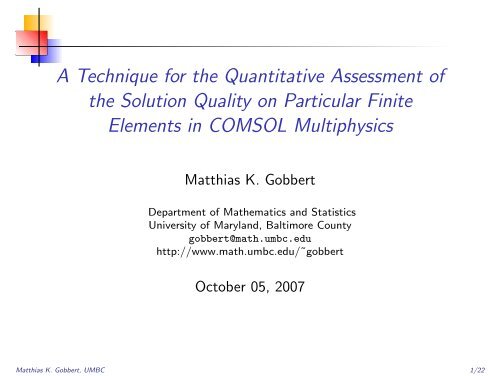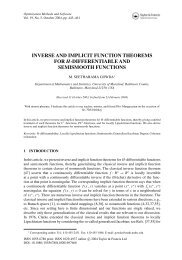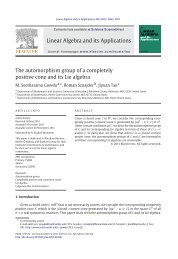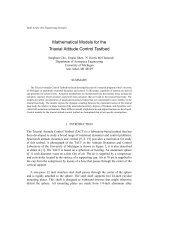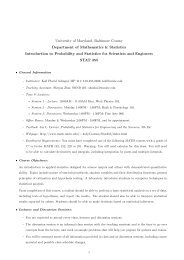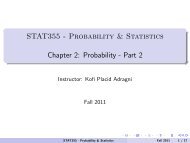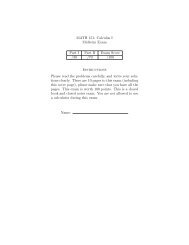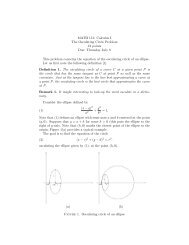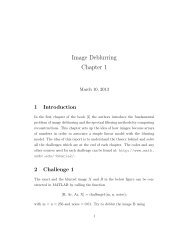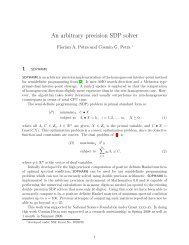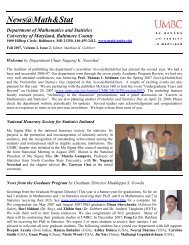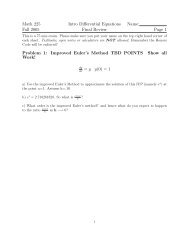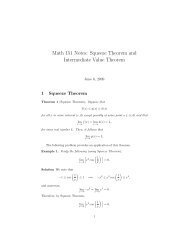Slides - Department of Mathematics and Statistics - UMBC
Slides - Department of Mathematics and Statistics - UMBC
Slides - Department of Mathematics and Statistics - UMBC
- No tags were found...
You also want an ePaper? Increase the reach of your titles
YUMPU automatically turns print PDFs into web optimized ePapers that Google loves.
A Technique for the Quantitative Assessment <strong>of</strong>the Solution Quality on Particular FiniteElements in COMSOL MultiphysicsMatthias K. Gobbert<strong>Department</strong> <strong>of</strong> <strong>Mathematics</strong> <strong>and</strong> <strong>Statistics</strong>University <strong>of</strong> Maryl<strong>and</strong>, Baltimore Countygobbert@math.umbc.eduhttp://www.math.umbc.edu/˜gobbertOctober 05, 2007Matthias K. Gobbert, <strong>UMBC</strong> 1/22
Problem StatementProblem: Assess the quality <strong>of</strong> a FEM solution quantitatively.Approach: Use guidance from the a priori error estimate‖u − u h ‖ L 2 (Ω)≤ C h q , as h → 0with a constant C independent <strong>of</strong> h <strong>and</strong> the convergenceorder q > 0. Here, h is the maximum side length <strong>of</strong> theelements in the triangulation.Concrete goal: Confirm that a given sequence <strong>of</strong> solutions onprogressively refined meshes behaves as predicted by the errorestimate.Matthias K. Gobbert, <strong>UMBC</strong> 2/22
Example <strong>of</strong> a Convergence StudyIf we have E r := ‖u − u h ‖ L 2 (Ω)≈ C h q on refinement level r,then E r := ‖u − u h ‖ L 2 (Ω)≈ C h q <strong>and</strong>E r−1 = ‖u − u 2h ‖ L 2 (Ω)≈ C 2 q h q ,then R r := E r−1 /E r ≈ 2 q <strong>and</strong> Q r := log 2 (R r ) = q,that is, Q r is a computable estimate for q.Example table <strong>of</strong> results:r DOF E r R r Q r0 25 3.74e-0031 85 1.01e-003 3.71 1.892 313 2.59e-004 3.90 1.963 1201 6.51e-005 3.98 1.994 4705 1.60e-005 4.07 2.025 18625 3.64e-006 4.40 2.14These results indicate that q = 2 for the PDE <strong>and</strong> FEM used.Matthias K. Gobbert, <strong>UMBC</strong> 3/22
Application to Linear Lagrange ElementsFor instance, for linear Lagrange FEM, the a priori error estimateholds with q = 2.The expected convergence rate for linear Lagrange elements isvalid, provided thatthe true solution u is smooth enough,the domain Ω is bounded, convex, <strong>and</strong> simply connected,<strong>and</strong> the domain boundary ∂Ω piecewise smooth, i.e., thedomain Ω can be discretized sufficiently well.On the one h<strong>and</strong>, if a sequence <strong>of</strong> solutions does not satisfy q = 2,then the PDE data <strong>and</strong> its domain may not be smooth enough.On the other h<strong>and</strong>, the test allows to assess how badly some <strong>of</strong> thetheoretical assumptions are violated <strong>and</strong> whether their violation isa serious problem.Matthias K. Gobbert, <strong>UMBC</strong> 4/22
OutlineThis talk will show how to do obtain a table as above usingCOMSOL Multiphysics <strong>and</strong> COMSOL Script for linear Lagrangeelements, without a known true solution.Solve the desired PDE in the GUI <strong>of</strong> COMSOL Multiphysics.Set up a function m-file getfem.m that solves the desiredPDE for a chosen refinement level as input argument.Write a driver script in COMSOL Script that calls getfem forr = 0, 1, . . . , r maxCompute the error ‖u − u h ‖ L 2 (Ω)using as reference solution foru the FEM solution on the finest mesh.Extensions, Limitations, <strong>and</strong> AlternativesMatthias K. Gobbert, <strong>UMBC</strong> 5/22
Example ProblemUse the default problem in the PDE Modes (stationary coefficientform) <strong>of</strong> COMSOL Multiphysics:− △ u = f in Ω,u = 0on ∂Ω,with f ≡ 1 on the unit square Ω = (0, 1) 2 ⊂ R 2 .Matthias K. Gobbert, <strong>UMBC</strong> 6/22
Create m-file getfem.mSolve desired problem in the GUI <strong>of</strong> COMSOL Multiphysics,using linear Lagrange elements. For best benefit:start COMSOL Multiphysics from scratch (to decrease theclutter in the m-file),use coarsest mesh possible in Mesh → Free Mesh Parameters(so we can refine as <strong>of</strong>ten as possible),refine the mesh once (to get the meshrefine comm<strong>and</strong> intothe m-file).Save As an m-file, which we will call from COMSOL Script.Matthias K. Gobbert, <strong>UMBC</strong> 7/22
Edit the m-file getfem.mEdit m-file as follows:Insert the function headerfunction fem = getfem (nref)Enclose the meshrefine comm<strong>and</strong> in a for-loop:% Refine meshfor nr = 1 : nreffem.mesh=meshrefine(fem, ...’mcase’,0, ...’rmethod’,’regular’);end;Delete the unneeded comm<strong>and</strong>s at the end <strong>of</strong> the m-file(i.e., the plot comm<strong>and</strong>s).Matthias K. Gobbert, <strong>UMBC</strong> 9/22
The Driver Script% set the max. number <strong>of</strong> refinements:nrefmax = 6;% reference solution on finest mesh:fem_ref = getfem (nrefmax);% obtain mass matrix for finest mesh:fema = fem_ref;fema.equ.c = 0;fema.equ.a = 1;fema.xmesh = meshextend (fema);[Mass,L,M,N] = assemble (fema);p_ref = fema.mesh.p;clear fema; % clear to save memory% interp. ref. sol. to ref. mesh:u_ref=postinterp(fem_ref,’u’,p_ref);for nref = 0 : nrefmax-1fem = getfem (nref);D(nref+1) = length(fem.sol.u);% interpolate sol. to ref. mesh:u_int=postinterp(fem,’u’,p_ref);% compute error as a column vector:e = u_ref(:) - u_int(:);% compute L2-norm <strong>of</strong> nodal error:E(nref+1) = sqrt(e’*Mass*e);end;R = E(1:nrefmax-1) ./ E(2:nrefmax);Q = log2(R);Matthias K. Gobbert, <strong>UMBC</strong> 11/22
Heart <strong>of</strong> the Driver ScriptFor-loop over the refinement level in right column <strong>of</strong> listing:compute fem for the refinement level nrefsave the number <strong>of</strong> DOF in vector Dinterpolate the FEM solution to the reference meshcompute the error between the interpolated solution <strong>and</strong> thereference solutioncompute <strong>and</strong> save the norm <strong>of</strong> its errorAfter the for-loop, compute the ratios R <strong>and</strong> the estimate Q to theconvergence order. The table shows then D, E, R, <strong>and</strong> Q.Need to explain:What is the reference solution <strong>and</strong> reference mesh?How is the norm <strong>of</strong> the error computed?Matthias K. Gobbert, <strong>UMBC</strong> 12/22
FEM Representation <strong>of</strong> the SolutionsThe FEM solution on a mesh is given by the expansionu h (x) =N∑u k ϕ k (x)k=1involving the FEM basis functions ϕ k (x), k = 1, . . . , N,where N is the number <strong>of</strong> DOFs <strong>of</strong> the mesh.For linear Lagrange elements, the basis functions satisfyϕ k (x l ) = 1 for k = l <strong>and</strong> = 0 otherwise. That is, u h (x k ) = u k <strong>and</strong>the expansion coefficients u k are the values <strong>of</strong> the FEM solution atthe mesh points x k <strong>of</strong> the triangulation.Hence, the vectors u_ref <strong>and</strong> u_int obtained by interpolating tomesh points p_ref <strong>of</strong> the reference mesh hold all expansioncoefficients <strong>of</strong> u <strong>and</strong> (interpolated) u h , respectively.Matthias K. Gobbert, <strong>UMBC</strong> 16/22
Norm Computation <strong>of</strong> the ErrorThe error e h = u − u h also has an expansionN∑N∑e h (x) = e k ϕ k (x) = e l ϕ l (x)k=1in terms <strong>of</strong> the FEM basis functions ϕ k (x), <strong>and</strong> the coefficients e kare the components <strong>of</strong> the vector e = u_ref(:) - u_int(:).Therefore, apply the definition <strong>of</strong> the L 2 -norm to find:∫∫ ( N) (‖e h ‖ 2 = ∑N)∑eL 2 (Ω) h e h dx = e k ϕ k (x) e l ϕ l (x) dx=N∑k=1 l=1ΩN∑(∫e kΩΩk=1)ϕ k (x)ϕ l (x) dx e l =l=1N∑k=1 l=1l=1N∑e k M kl e l = e T Mewith the mass matrix M kl = ∫ Ω ϕ k(x) ϕ l (x) dx, thus the norm iscomputed as sqrt(e’*Mass*e).Matthias K. Gobbert, <strong>UMBC</strong> 18/22
ExtensionsExtensions using the same driver script due to its abstractformulation:other domains, PDEs, etc. instead <strong>of</strong> this example problem,other spatial dimensions (e.g., 3-D),quadrilateral elements (with linear FEM basis functions),transient PDEs (at selected times each).Extensions requiring modification <strong>of</strong> the driver script:other application modes (name <strong>of</strong> the solution is not u),quadratic Lagrange elements (refine reference mesh once).systems <strong>of</strong> PDEs (apply to each component)Matthias K. Gobbert, <strong>UMBC</strong> 21/22
Alternatives <strong>and</strong> LimitationsAlternatives to <strong>and</strong> limitations <strong>of</strong> the suggested procedure:a posteriori error estimates (designed to measure error fromcomputable quantities), though it is valuable to be able tocheck the a priori error when it is available,the computation <strong>of</strong> the mass matrix in other modes not thesame,the approach cannot h<strong>and</strong>le higher-degree or non-Lagrangeelements =⇒ I am interested in suggestions how to make thisgeneral for more or all FEM in COMSOL!also any other suggestions for how to use COMSOL’sfunctionality better is welcome.The extension to higher-order elements is relevant, because theresults <strong>of</strong> a convergence study indicate whether an excessivepolynomial degree <strong>of</strong> the basis functions is used.Matthias K. Gobbert, <strong>UMBC</strong> 22/22


